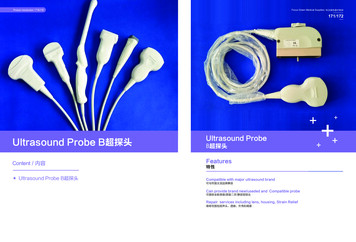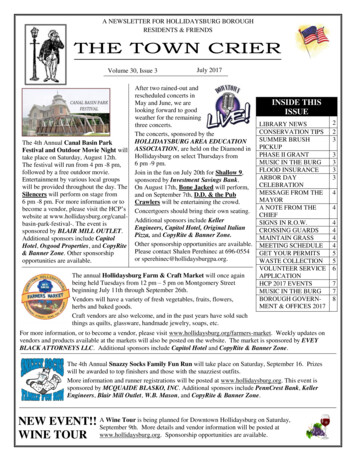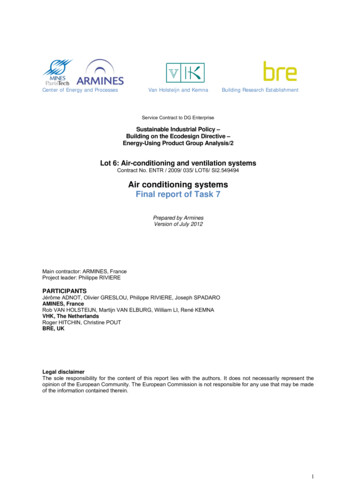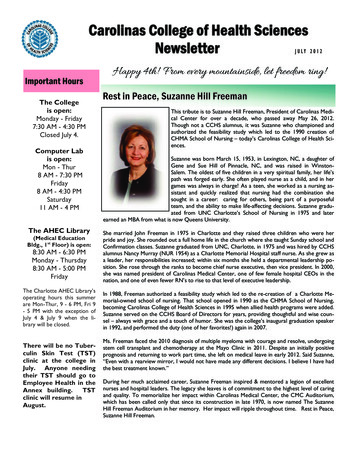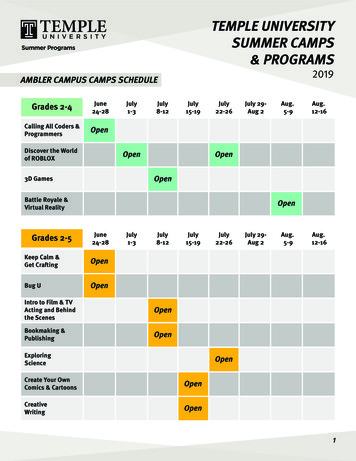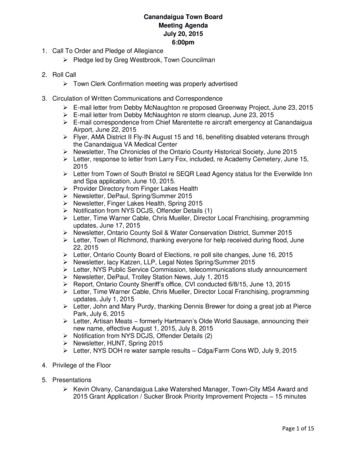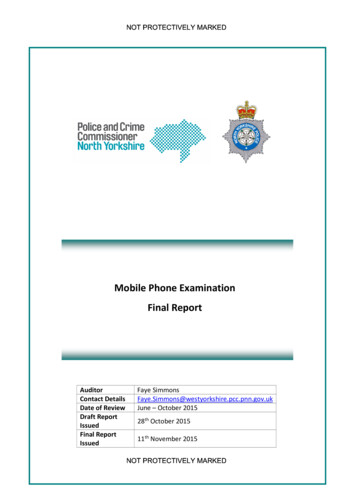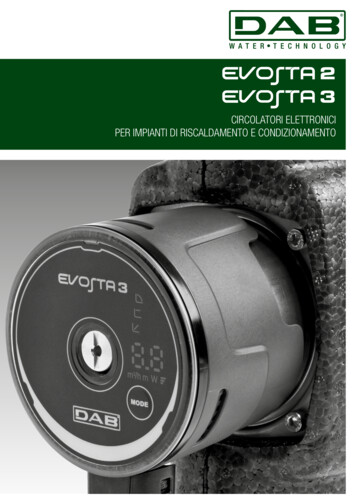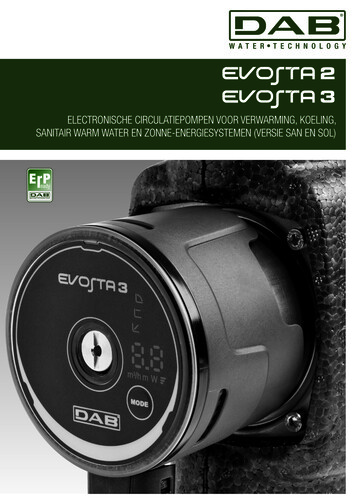
Transcription
Preparatory study forimplementing measures ofthe Ecodesign Directive2009/125/ECDG ENTR Lot 9 Enterprise servers anddata equipmentTask 4: TechnologiesJuly 2015 – Final report1DG ENTR Lot 9 - Enterprise servers and data equipment Task 4: Technologies
Document InformationClientEuropean Commission, DG InternalIndustry, Entrepreneurship and SMEsMarket,Specific Contract N 185/PP/ENT/IMA/12/1110333Framework Contract N ENTR/29/PP/2010/FC LOT 2Report TitlePreparatory study for implementing measures of theEcodesign Directive 2009/125/EC DG ENTR Lot 9 Enterprise servers and data equipment - Task 4:TechnologiesProject NamePreparatory Studies for Product Group in theEcodesign Working Plan 2012-2014: Lot 9 –Enterprise servers.Project CodeENTR Lot 9Project TeamBio by Deloitte, Fraunhofer IZMDate31 July 2015Mr. Anton Berwald, Bio by DeloitteMr. Thibault Faninger, Bio by DeloitteMs. Sara Bayramoglu, Bio by DeloitteAuthorsMr. Benoît Tinetti, Bio by DeloitteMr. Shailendra Mudgal, Bio by DeloitteDr. Lutz Stobbe, Fraunhofer IZMDr. Nils Nissen, Fraunhofer IZMMr. Anton Berwald, Bio by Deloitteaberwald@deloitte.frKey ContactsorMr. Benoît Tinetti, Bio by Deloittebtinetti@deloitte.frDisclaimerThis report was prepared for the EuropeanCommission. However, it contains the results ofresearch by the authors and is not to be perceivedas the opinion of the European Commission.The project team does not accept any liability for anydirect or indirect damage resulting from the use ofthis report or its content.Please cite this publication as: Bio by Deloitte (2015), Preparatory study for implementing measures ofthe Ecodesign Directive 2009/125/EC DG ENTR Lot 9 - Enterprise servers and data equipment - Task 4:Technologies2DG ENTR Lot 9 - Enterprise servers and data equipment Task 4: Technologies
Table of ContentsDOCUMENT INFORMATION 2TABLE OF CONTENTS 3LIST OF FIGURES 5LIST OF TABLES 6GLOSSARY 71. TECHNICAL PRODUCT DESCRIPTION 91.1. Existing products (working towards the definition of Base-Cases) 91.1.1. Objective and structure of the report 91.1.2. Product overview 91.1.3. Enterprise servers 111.1.3.1. Server components and subassemblies 111.1.3.2. Chassis 121.1.3.3. Printed circuit board 131.1.3.4. Processor and memory 141.1.3.5. Passive and active cooling system 201.1.3.6. Power supply unit and converters 231.1.3.7. Hardware configuration and form factor 261.1.4. Enterprise storage 291.1.4.1. Storage devices and system elements 291.1.4.2. Hard disk drives (HDD) 301.1.4.3. Use of neodynium and other rare earth elements in HDD 331.1.4.4. Solid state devices (SSD) 341.1.4.5. Redundant array of independent disks (RAID) 361.1.4.6. Massive array of idle disks (MAID) 381.1.4.7. Storage system form factor and configuration 381.1.5. Server and storage connectivity and architecture 391.1.5.1. Direct attached storage (DAS) 391.1.5.2. Storage area network (SAN) 391.1.5.3. Network attached storage (NAS) 401.1.6. Network protocols 411.1.6.1. Small Computer System Interface (SCSI) 411.1.6.2. Serial Attached SCSI (SAS) 421.1.6.3. Serial Advanced Technology Attachment (SATA) 421.1.6.4. Fibre Channel (FC) 431.1.6.5. Fibre Channel over Ethernet (FCoE) 431.1.6.6. Internet Small Computer System interface (iSCSI) 431.1.6.7. Infiniband (IB) 441.1.7. Enterprise network equipment 441.1.7.1. LAN Switch 441.1.7.2. Cables and cabling 451.2. Products with standard improvement (design) options 471.2.1.1.2.2.1.2.3.1.2.4.1.2.5.3Latest component generation 47Storage media and utilization 47Power management 48Effective data processing 48Virtualisation 48DG ENTR Lot 9 - Enterprise servers and data equipment Task 4: Technologies
1.2.6.1.2.7.1.2.8.1.2.9.Modular design 48Efficient power supply 48Thermal management 49Higher inlet temperature 491.3. Best Available Technology (BAT) 501.3.1.1.3.2.1.3.3.1.3.4.1.3.5.1.3.6.Power supply unit (PSU) 50Microprocessors and memory 51Hard disk drives and storage 52Modular Servers and Microservers 53Advanced cooling 54Data Centre Infrastructure Management (DCiM) 551.4. Best Not yet Available Technology (BNAT) 561.4.1. Processor and memory development 561.4.2. HDD development 561.4.3. Advanced Cooling 562. PRODUCTION, DISTRIBUTION AND END-OF-LIFE 572.1. Production, distribution and end-of life phases of enterprise servers 582.1.1.2.1.2.2.1.3.2.1.4.The production phase of a rack server 58The production phase of a blade system 59The distribution phase for a rack server and blade system 59End-of-life phase of an average rack server and blade system 602.2. Production, distribution and end-of-life phase of enterprise storage 602.2.1. The production phase of a storage system 602.2.2. Distribution phase of the storage system 622.2.3. End-of-life phase of the storage system 623. RECOMMENDATIONS 633.1. Refined product scope from the technical perspective 633.2. Barriers and opportunities for Ecodesign from a technical perspective 633.3. Typical design cycle 63ANNEX 644DG ENTR Lot 9 - Enterprise servers and data equipment Task 4: Technologies
List of FiguresFigure 1 : Enterprise server - main subassemblies . 12Figure 2 : Principle schemata of CPU, memory, chipset and interfaces . 17Figure 3 : Principle schemata - CPU package and socket . 18Figure 4 : Air cooling system . 21Figure 5 : Interpolated 80 PLUS certification criteria for power supplies (based on 80 PLUS Certification) . 25Figure 6 : Schematic diagram of a rack-server. 27Figure 7 : Schematic diagram of a blade-server. 28Figure 8 : Schematic diagram of a HDD . 31Figure 9 : Schematic diagram of a SSD . 35Figure 10 : Schematic diagram of direct attached storage . 39Figure 11 : Schematic diagram of storage area network . 40Figure 12 : Schematic diagram of network attached storage . 41Figure 13 : Average power consumption of different cable ports in 2009 [Schneider 2010] . 45Figure 14: Examples of common server designs . 53Figure 15: HP Moonshot outline . 54Figure 16: Illustration of a blade system . 59Figure 17: Illustration of two DAEs . 605DG ENTR Lot 9 - Enterprise servers and data equipment Task 4: Technologies
List of TablesTable 1: Intel Xeon Processor Overview . 16Table 2: Exemplary power consumption of memory according to HP . 19Table 3: Exemplary power consumption of memory . 20Table 4: Current price ranges for single PSUs (Sources: Various websites). 25Table 5: Enterprise servers – typical form factor and product examples . 29Table 6: 3.5" HDD - Technical Data . 32Table 7: 2.5" HDD - Technical Data . 32Table 8: Exemplary enterprise HDD power consumption (Seagate) . 33Table 9: Exemplary enterprise SSD power consumption, 200 GB capacity . 36Table 10: Exemplary enterprise SSD power consumption, 400-800 GB capacity . 36Table 11: Exemplary enterprise SSD power consumption, more than 800 GB capacity . 36Table 12: RAID system comparison . 37Table 13: Selected specifications of a 2.5 inch FUJITSU Eternus DX80. 38Table 14: Selected specifications of a 3.5 inch FUJITSU Eternus DX80. 39Table 15: SCSI Specifications . 41Table 16: SAS selected Specifications . 42Table 17: SATA selected Specifications. 43Table 18: FC Specifications . 43Table 19: IB Specifications . 44Table 20: Comparison of Fibre and Copper cables [Neveux 2008] . 46Table 21: 80 PLUS Titanium conversion requirements . 50Table 22: Comparison of power supply efficiencies at different PSU ratings provided by DIGITALEUROPE . 50Table 23: Example for a new blade design by Noctua . 55Table 24: Bill of materials of an average rack server . 58Table 25: Bill of materials of a blade system with 8 servers . 59Table 26: The distribution phase of a rack server and a blade system . 59Table 27: End-of-life phase of enterprise servers . 60Table 28: Bill of materials of 0.5 controller . 61Table 29 : Bill of materials for two Disc Array Enclosures (DAEs) . 61Table 30 : Bill of materials for an average storage media mix . 61Table 31: The distribution phase for storage systems . 62Table 32: The end-of-life phase of storage systems . 62Table 33: Bill of Materials - Rack Server . 64Table 34: Bill of Materials - Blade System . 66Table 35: Bill of Materials - Storage Unit . 686DG ENTR Lot 9 - Enterprise servers and data equipment Task 4: Technologies
ternating CurrentAccess Control ListsAmerican Society of Heating, Refrigerating and Air-Conditioning al ExpenditureController EnclosureComplementary Metal Oxide SemiconductorCentral Processing UnitDirect CurrentDouble Data RateDisk EnclosureDual Inline Memory ModuleDynamic RAMEuropean CommissionError-correcting CodeEnergy Efficient EthernetElectroless Nickel Immersion GoldEnergy-related ProductsEuropean UnionFibre ChannelFibre Channel over EthernetFront-End-of-LineGraphic Processor UnitHot Air Solder LevellingHost Bus AdapterHard Disk DriveHigh Performance ComputingInfinibandIntegrated circuitInformation and Communication TechnologyIntrusion Detection SystemIntegrated Heat SpreaderIntegrated Load MechanismInput OutputInput Output Per Secondinternet Small Computer System InterfaceLocal Area NetworkMethodology for the Ecodesign of Energy-related ProductsMulti-Level CellMean Time Between FailuresNetwork File ServiceOriginal Equipment ManufacturerDG ENTR Lot 9 - Enterprise servers and data equipment Task 4: Technologies
rational ExpenditureOrganic Solder PreservativePrinted Circuit BoardsProduct Carbon FootprintPlatform Controller HubPin Grid ArrayPower Supply UnitQuality of ServiceQuick Path InterconnectRedundant Array of Independent DisksRandom Access MemoryRack UnitSerial Attached SCSISerial Advanced Technology AttachmentSmall Computer System InterfaceSynchronous Dynamic Random Access MemoryService Level AgreementSingle-Level CellSwitched-Mode Power SuppliesSurface-mount technologyStorage Networking Industry AssociationStandard Performance Evaluation CorporationStatic RAMSolid State DevicesThermal Design PowerThrough-hole technologyThermal Interface MaterialUninterruptible power supplyVirtual Private NetworkDG ENTR Lot 9 - Enterprise servers and data equipment Task 4: Technologies
1.Technical product description1.1. Existing products (working towards the definition of Base-Cases)1.1.1. Objective and structure of the reportAccording to MEErP, this task aims to explain in easy-to-understand wording for non-experts what physical orchemical processes are involved in the functional performance of the product, in particular where suchprocesses are responsible for resources use and emissions. At the same time, the explanation is also directedat technical experts, presumably the designers and developers of the industry placing the products on themarket. This means that it should be identified and reported what the latest research findings are and whatthey would imply for the future functional and environmental performance.The following section 1.1.2 provides a general overview of the main technical and environmental aspects ofexisting products. The remaining sections are for capacity building and they provide detailed technicaldescriptions of server and storage system designs, product configurations, and subassemblies. The reportalso addresses the connectivity and network technologies in conjunction with system architecture of existingserver and storage systems.Finding an effective methodical approach to this technical product description has been a challenge. Accordingto MEErP, it is required to describe all technical and environmental aspects directly on a product level. Thiswould mean to describe enterprise servers, storage and network equipment independently. But this approachhas some limitations.The investigation of existing products indicated a tremendous variety of existing technologies, product featuresand component configurations. The reason for this product spectrum is related to a number of factors including: Very fast technology cycles in the semiconductor / microelectronics industry Competing connectivity / network standards Functional / technical convergence on product level Operational requirements (e.g. these requirements include latency, capacity, reliability, andserviceability and are defined in individual Service Level Agreements - SLA) Operating condition and allowances on data centre level CAPEX and OPEX considerationsAgainst that background, it seems important to develop a basic understanding for the complex, functionalsystem interaction between servers and storage equipment (connectivity) and the influence of surroundingoperational conditions. Therefore, in the description of connectivity technologies, integrated network interfacesand independent network elements were included directly in conjunction with the description of servers andstorage products.The analysis leads to the conclusion that the environmental impact of the ENTR Lot 9 products depends moreupon the system design, than on the product design. The following sections provide background information,data and summaries concerning not only the existing products but also concerning the system design, systeminteraction and utilisation of the product within a system effort.1.1.2. Product overviewEnterprise servers and storage equipment are commercial information and communication technology (ICT)sold in the business-to-business (B2B) market. Server and storage products provide individual functionalities.They are two separate product categories and further sub-categories have been defined in order to distinguishcertain applications, performance and form factors. It is furthermore important to recognise the fact that serverand storage equipment are mostly operated interconnected. The workload is typically distributed to a largerpool of products. The provided IT services (e.g. user benefit, useful work) are not created by a single machinebut through a combined (virtual) server and storage environment. Connectivity and interoperability areessential aspects of server and storage equipment. The technologies, software, and specific products appliedto facilitate connectivity are manifold and considered a distinct and specific spectrum of products.Due to the fact that the majority of server and storage equipment are pooled together, specific mounting optionsand deployment environments have been developed over the past decades. Most of the server and storageequipment is designed to be mounted in standard 19-Inch racks (cabinets) and placed in air-conditioned server9DG ENTR Lot 9 - Enterprise servers and data equipment Task 4: Technologies
rooms or data centres. The rack and room level support infrastructure is considered in this study through the“technical system” approach. This rack and room level infrastructure is not considered part of the server orstorage product. However, this support infrastructure is absolutely necessary for safe, secure and reliableoperation. It basically includes cooling and air conditioning infrastructure as well as uninterruptible powersupply (UPS) and power distribution equipment. Fire safety, condition monitoring, physical security and otheraspects are also part of the infrastructure.Even if the study scope is not the data centre facility and particular infrastructure equipment, it is necessary torecognise that the local conditions (e.g. climate, cooling options) in which the ICT equipment is operated havean influence on the technical performance and the environmental impacts of the products (see Task 3 for moredetails).Current enterprise servers and storage equipment are designed in a more and more modular way. Vendorsoffer many different configuration options in order to adjust performance and price to the needs of thecustomers. The products can be distinguished by various aspects including: Purchasing price: This is an indicator for a certain performance and quality of components andit reflects the hardware and software configuration. Hardware configuration: The type and number of processors, memory and storage capacity,and interfaces are indicating the performance spectrum and intended application. Software configuration: The type of operation system, applied software (proprietary or opensource) and virtualisation capability as well as the applied network protocols in storage systemsfor instance are also indicating the performance spectrum and intended application. Form factor: This is an indicator for the level of system integration, modularity and scalability offunctional components. There is a trend towards smaller form factors and multi-functionality incurrent product design. Allowable operating conditions: Products are offered for different operating conditions includingthermal and humidity specifications.Previous investigations indicate that the primary environmental impact of enterprise servers and storageequipment is related to the electricity consumption in use phase. Nevertheless, the materials and processesused for manufacturing the specific hardware elements are also contributing to the overall environmentalimpact particularly in impact categories linked to resource use. The manufacturing of electrical,electromechanical, electronic and photonic components is in general resource intensive. The followingcomponents can be considered in that respect: Large-size, multilayer printed circuit boards (PCB) populated with semiconductor-based activecomponents (ICs) such as processors (CPU, GPU), memory (RAM), storage devices (HDD,SSD) as well as the full range of passive electronic devices. Active and passive cooling elements such as fans, heat-sinks or heat-pipes, which typicallyconsists of aluminium, copper or a combination of both. One or multiple (redundant) power supply units (PSU) including big caps and coils Cables for power supply and communication (copper or glass fibre) Global distribution of the supply chain and manufacturing process (transport)The hardware is to a very large extent produced outside of the European Union. The material composition ofthe products is changing slightly over time, mostly due to new technologies in the semiconductor and electronicpackaging field. The continuously growing demand for bandwidth and higher frequencies will lead to anincreasingly larger introduction of photonic technologies and related materials such as Gallium, Germanium,and Indium in III-V semiconductor components. Furthermore, the steady miniaturisation (Moore’s Law) isleading to higher and higher energy density. This trend demands also the utilisation of new materialcompositions and structures on the chip level in combination with novel cooling systems. This in turn couldimpact the complexity and environmental footprint of the manufacturing processes.Finally, the material recovery in the end-of-life treatment is not yet at an optimum. There is a variety of materialsthat are not fully recovered from the products at the present. Nevertheless, the industry already recognisesthe material value of the products and individual stakeholders are implementing refurbishment, dismantling,and recycling schemes in their business.Existing product carbon footprints (PCF) of enterprise servers, conducted by leading manufacturers andenvironmental assessment experts, indicate that over the whole product life cycle, the use phase is the most10DG ENTR Lot 9 - Enterprise servers and data equipment Task 4: Technologies
contributing life cycle phase (more that 80% of the total PCF, see Task 3). The following aspects have to beconsidered in that respect: The products are typically operated 24/7 for a period of 3 to 7 years, and are always online.Standby/off mode is not a common practice due to prolonged reactivation time on a systemlevel. Average server utilisation is currently still quite low (typically 20% load). Server utilisation isslowly increasing and primarily driven by virtualisation. Moore’s Law is still contributing strongly to periodical performance increase and relatedimprovement of energy efficiency. Performance and power consumption are always addressedtogether in technology development. The operating conditions including cooling infrastructure and energy supply are directly relatedto the power consumption of the products. It is necessary to consider energy trade-offs betweenthe ICT equipment and the supporting infrastructure as being relevant for energy savings onsystem level (data centre).The energy consumption in the use phase is influenced by the technology level of the hardware as well as bythe conscious deployment of a product for the right purpose. In other words, the specific hardware and softwareconfiguration determines the power consumption in relation to the functional performance. This include
1 DG ENTR Lot 9 - Enterprise servers and data equipment Task 4: Technologies Preparatory study for implementing measures of the Ecodesign Directive 2009/125/EC DG ENTR Lot 9 - Enterprise servers and data equipment Task 4: Technologies
